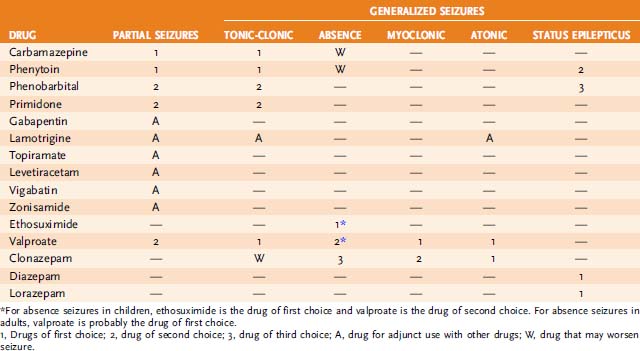Chapter 9 Anticonvulsant Drugs
• Seizures are episodes of abnormal electrical activity in the brain that may lead to involuntary movements and sensations, which are accompanied by characteristic changes on electroencephalography (EEG).
• Increased risk of suicidal behavior or ideation (U.S. Food and Drug Administration [FDA] Special Alert; February 2008)
TABLE 9-1 International Classification of Partial and Generalized Seizures
| Classification | Origin and Features |
|---|---|
| Partial (Focal) Seizures | Arising in one cerebral hemisphere |
| Simple partial seizure | No alteration of consciousness |
| Complex partial seizure | Altered consciousness, automatisms, and behavioral changes |
| Secondarily generalized seizure | Focal seizure becoming generalized and accompanied by loss of consciousness |
| Generalized seizures | Arising in both cerebral hemispheres and accompanied by loss of consciousness |
| Tonic-clonic (grand mal) seizure | Increased muscle tone followed by spasms of muscle contraction and relaxation |
| Tonic seizure | Increased muscle tone |
| Clonic seizure | Spasms of muscle contraction and relaxation |
| Myoclonic seizure | Rhythmic, jerking spasms |
| Atonic seizure | Sudden loss of all muscle tone |
| Absence (petit mal) seizure | Brief loss of consciousness, with minor muscle twitches and eye blinking |

(From Kester M, et al.: Elsevier’s Integrated Pharmacology. Philadelphia, Mosby, 2007, Figure 13-3.)
II. Drugs Used in the Treatment of Partial Seizures and Generalized Tonic-Clonic Seizures (Box 9-1; see also Table 9-2)
BOX 9-1 Anticonvulsants
b. First-order kinetics (low blood levels) can switch to zero-order kinetics (high blood levels), i.e., dose-dependent pharmacokinetics.
b. Fosphenytoin is given to control generalized convulsive status epilepticus and prevent and treat seizures occurring during neurosurgery
Stay updated, free articles. Join our Telegram channel

Full access? Get Clinical Tree




